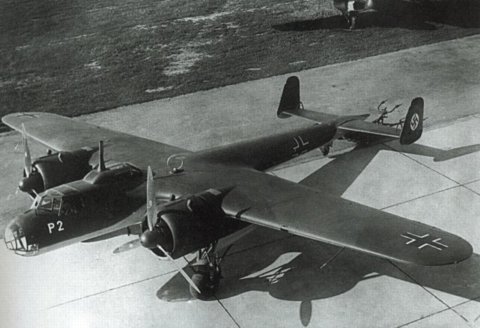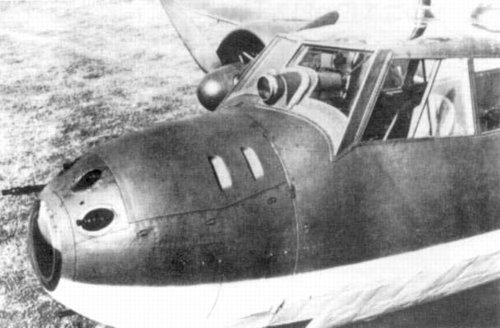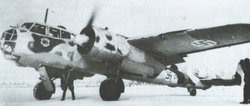Dornier Do 17
|
|
The Dornier Do 17, sometimes referred to as the Bleistift ("pencil") by its pilots, was a World War II light bomber produced by Dornier that was used for a short time by the Luftwaffe. It quickly became outdated, and was removed from front-line service as soon as enough Junkers Ju 88s were available. A small run of an updated version known as the Do 215 was also produced, and ended almost as quickly.
| Contents |
Background and Prototypes
When Lufthansa started expanding in the early 1930s they placed orders for planes that pushed the state of the art, and a number of companies took this opportunity to invest in new design and construction techniques. The result was a number of world-beater designs like the Heinkel He 70 Blitz and Focke-Wulf Fw 200 Condor. In 1933, Dornier thought it would enter the market as well, and started the design of a fast twin-engine plane in response to a Lufthansa tender for a six-passenger mail plane. The result was the Do 17.
In order to compete with planes like the He 70, the Do 17 was made as small as possible in cross section to reduce drag. The plane was so skinny that it quickly earned the name flying pencil (bleistift). Three prototypes were built for Lufthansa and were tested in 1935, but they were eventually returned to Dornier. In test service the passengers complained that it was terribly uncomfortable inside the tiny cabin, they even had a hard time just getting into it.
As luck would have it, a former Dornier employee and new Luftwaffe pilot, Flugkapitän Untucht, visited the plant and test-flew one of the prototypes. He decided that it had potential as a light bomber, but felt it needed more vertical surface for stability. Soon the RLM (the German Air Ministry) asked Dornier to produce seven more prototypes for combat trials with a new twin-rudder design. The design was successful, and the plane was looked upon as the first example of the schnellbomber concept: bombers built to be fast enough to outrun fighters. For a time it was felt that bombers would retain their speed advantage over fighters due to their extra power, leading many to assume that the bomber will always get through.
Do 17E and F
The prototypes had mounted the excellent Daimler-Benz DB 600 engines, but these were constantly in short supply. Production started instead with the BMW V1 radial engine, creating the Do 17E-1 bomber and Do 17F-1 reconnaissance versions. The bombload of the E-1 was a measly 500 kg, hardly 10% more than the contemporary Bristol Blenheim's, and the two defensive MG15 machine guns were in a hut on the roof and a small hatch in the floor that offered almost no angle of fire.
Do 17K
After seeing the Do 17M at the Zürich air races in 1937, the Yugoslavian Air Force bought licence rights for production at Drazavna Fabrika Aviona. They equipped it with the considerably better Gnome Rhône 14N engines and added a 20 mm Hispano cannon and three 7.92 mm Browning machine guns. Seventy had been produced by April 1941 when the country was invaded by German forces. Most were destroyed but two of them fled the country with a load of gold on board.
Do 17L and M
The Do 17L-0 and Do 17M-0 were developed in parallel as replacements for the earlier E and Fs, the L being the reconnaissance version. Both were designed around the more powerful DB 600A engines, delivering about 1,000 hp (750 kW). Two L and one M versions were built as prototypes, both with another MG15 in the nose.
The feasibility of the schnellbomber was tested at the International Military Aircraft Competition at Zürich in 1937, where the Do 17M prototype finished ahead of all the fighters in the competition.
The supply of the DB 600 was extremely limited, and priority had to be given to the Messerschmitt Bf 109. Production versions of the basic M model airframe were then fitted with the new BMW Bramo 323A-1 Fafnir of 900 hp (670 kW), which gave reasonable performance and raised the bombload to 1,000 kg. The resulting Do 17M-1 was produced in small numbers and operated until the first year of the war, when they were withdrawn and sent to training units.
Do 17P
 |
| Do 17P-1 |
The L version would not be able to enter production with the DB 600, and the Bramo engine was rather thirsty and left the M models with too short a range for use in the reconnaissance roll. The BMW 132N radials of 865 hp (645 kW) were selected instead, which had lower fuel consumption for better range. This Do 17P-1 was produced in some number, but why this version was not called the L-1 is a mystery.
Another two prototypes with DB 600 engines were produced as the Do 17R-0, but did not enter production.
Do 17S and U
When the Soviet Polikarpov I-16 monoplane arrived over Spain where the Do 17Ps were being tested, the woeful armament clearly needed an upgrade. A completely new pod-like cockpit was designed for the plane to give the crew more room and better visibility. The roof was extended upward over the line of the fuselage, sloping down to meet it just in front of the wing. The dorsal gun was moved to the rear of the pod where it had a considerably better field of fire. Likewise, the floor was dropped under the fuselage and the ventral gun moved to the back of the pod, allowing it to fire directly to the rear. The changes in the roof and floor made the whole front of the plane much larger. The new cockpit became the standard for the Junkers Ju 88 and other bombers. While no longer so slim like its predecessor, it was still more or less referred to as the flying pencil.
Three prototypes with the DB 600 inverted vee engines were constructed as the Do 17S-0 reconnaissance versions, but did not go into production. An additional fifteen Do 17U-1 pathfinder models were built, similar to the S but adding an additional crewman (to five) to operate the complex radio equipment. The U models were to fly in ahead of other bombers on night missions, using the radio equipment to locate the target and drop flares on it. They were personally requested by KG 100 as experimental models for this role. The use of the DB's engines also led to the creation of the Do-215.
Do 17Z
Wide-scale production finally settled on the definitive Do 17Z models. At first a batch of Z-0s were built with the Fafnir for testing, the DB 600 again proving to be too hard to come by. These were quickly replaced with the Z-1 model, which added another gun for the bombardier, but the additional weight of the nose and guns meant the bombload was reduced to 500kg.
This was addressed in the major production model, the Do 17Z-2. The Z-2 mounted the new 323P version of the Fafnir with 1,000 hp (750 kW), and the extra power allowed the bombload to be increased back to 1000kg. Once again, the armament was upgraded by adding an additional pair of guns firing out of the sides of the upper part of the pod, but the three guns were all fired by a single gunner, meaning that two of them were always dead weight. Although the performance was reasonable, the extra power reduced the fully loaded combat range to a tiny 205 miles.
Modifications of the basic Z-2 model included the Z-3 reconnaissance version, the Z-4 dual-control trainer, and the Z-5 which included float cells in the fuselage and engine nacelles in case it was forced down on water. Some 537 Z-2s were produced before the lines shut down in July 1940.
During the Polish campaign, the plane could use its 265 mph (427 km/h) maximum speed to stay away from most enemy fighters, and its light armament was almost enough, but by the time it met British planes, notably over England during the Battle of Britain, it was hopelessly outclassed, typically eight guns to one rear gun. It could still sometimes outrun the Hurricanes in a slight dive, but since the Fafnir engine was good only at low altitudes they instead switched to terrain-following mass raids which worked well. Still the Do 17s (as well as Junkers Ju 88s and Heinkel He 111s) were butchered over England.
With the introduction of its replacement the Junkers Ju 88, its days were numbered, and production ended in 1940. However, it still proved to be useful and resulted in becoming the worlds first dedicated night fighter! Other surviving planes were used as test beds for new technologies and other handed off to allied nations over the next two years. It was also the template for the much larger and totally new yet similarly looking Dornier Do 217.
Do 17Z-10 Kauz
 |
| Do 17Z-10 |
| The Spanner IR detector is visible in the window |
After bomber production ended in 1940, the Z model was modified with a "solid" nose from the Ju 88C and fitted with one 20 mm MG-FF cannon and three 7.92 mm MG17s to be used as night fighters. One prototype was constructed as the Z-6 Kauz I (screech-owl), and then the design was further modified with a custom nose with four 7.92 mm MG17 machine guns and four 20 mm MG-FF cannons. Only nine of these Do 17Z-10 Kauz II designs were built, fitted the Spanner-I/II infrared detection system. As the spanner proved to be essentially useless, these planes got an upgrade to FuG 202 Lichtenstein B/C Radar in late 1941.
The Z-10 served for two years in the night fighter role, where they were used in Josef Kammhuber's defensive system known as the Kammhuber Line. Each fighter was assigned a single "cell", with three strips of such cells running from Denmark to the middle of France. Within each cell a direction center on the ground tracked both the Kauz and a single target, guiding them until the target was visible in the Spanner. RAF Bomber Command were able to ascertain the nature of the line, and sent all of their bombers in a single "stream", thus overwhelming the defenses. The Z-10s were then replaced with more capable planes mounting their own radars.
Do 215
 |
| Do 215 |
The Do 215 was developed as an export version of the Do 17Z series, but fitted with the much more powerful 1,100 hp (809 kW) Daimler-Benz DB 601B-1 engine. Performance was greatly improved, with top speed increasing to 280 mph (450 km/h) and service ceiling to over 31,000 ft (9,400 m).
Eighteen Do 215A-1 were built for export to Sweden in 1939, but were embargoed and instead put into service with the Luftwaffe as the Do 215B-1 and Do 215B-2. Two aircraft were sent to the Soviet Union as Do 215B-3s, otherwise unchanged. The Do 215B-4 was a reconnaissance aircraft similar to the Z-3. The Do 215B-5 Kauz III was a night fighter, similar to the Do 17Z-10. In total another 101 planes were completed as Do 215s.
The last of the Flying Pencils did serve in the Luftwaffe until late 1944. It never really distinguished itself in combat, but was a solid performer that made it an important part of the Luftwaffe to nearly the end.
|
Lists of Aircraft | Aircraft manufacturers | Aircraft engines | Aircraft engine manufacturers Airports | Airlines | Air forces | Aircraft weapons | Missiles | Timeline of aviation |

